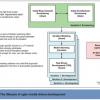|
How to Fail Less and Enjoy More The shiniest software application in the world, shipped on time and under budget, is a failure if it doesn't make someone's job easier. Failures cost us customers and money. How can we design software that our customers want to use and that will reduce our cost of failure? |
Frédéric Boulanger
May 30, 2008 |
|
 |
Advice for the New Leader As a new manager it's easy to fall into the trap of taking on more of your team's responsibilities than you should. Learn how to guide your team to success by stepping back and letting team members solve their own problems, learn from their mistakes, and most of all do what you hired them to do. |
|
|
The Mission Is the Message A mission statement is supposed to guide and inspire the members of an organization as well as define the organization's purpose, the business it is in, and its responsibilities to its clients. Is your statement sending the right message? |
||
 |
Stop The Insanity! Using Root Cause Analysis to Avoid Repeating Your Mistakes We've all heard Einstein's definition of insanity, and it definitely holds true in software development. We "are" going to make mistakes in product development, but root-cause analysis can help us understand those mistakes and be proactive in not repeating them. |
|
 |
The Myth of Risk Management Risk management is an illusion. We must recognize that software projects are inherently risky and admit to ourselves that it's not the known problems that are going to cause our projects to fail. It's the risks that are unmentionable, uncontrollable, unquantifiable, or unknown that make projects crash and burn. |
|
 |
Agile Model-Driven Development Despite what you might have heard, modeling is an important part of agile software development. Find out how agile model-driven development fits into the overall agile development lifecycle in a lean and streamlined manner and can improve productivity on your team. |
|
|
|
A ''D'' in Programming, Part 2 In his final pitch for the D programming language, Chuck brings to "closure" (pun intended) a running example from previous Code Craft articles while exploring some powerful features of the D language. |
|
|
Know Where Your Wheels Are Drawing from his experiences while learning to drive, Michael applies lessons he learned from written rules, experiential learning, and the advice of mentors to teaching new testers some valuable skills. |
||
|
When to Step Up, When to Step Back Leaders can stifle progress when they unnecessarily interfere with team processes. However, as a leader, you don't want your project to go over the cliff and fail miserably or deliver the wrong results either. There are times when leaders should stand back and let the team work things out for themselves—and other times when leaders should step up and really lead. |
Pollyanna Pixton
May 1, 2008 |
|
 |
The Accidental Complexity of Logic Much code complexity and no small number of program defects can be traced back to confusion over logical expressions and the expression of logic. Find out how you can get that complexity under control. |
Pages
Upcoming Events
| Apr 27 |
STAREAST Software Testing Conference in Orlando & Online |
| Jun 08 |
AI Con USA An Intelligence-Driven Future |
| Sep 21 |
STARWEST Software Testing Conference in Anaheim & Online |
| Oct 27 |
STARCANADA Software Testing Conference in Toronto |











